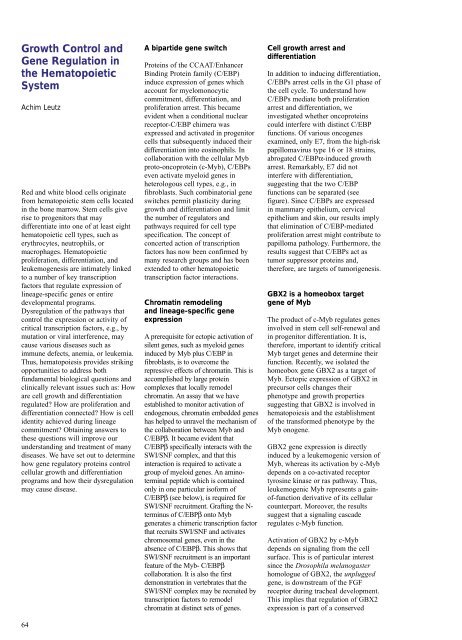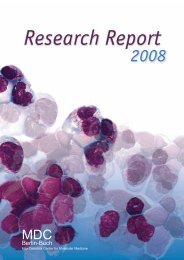Create successful ePaper yourself
Turn your PDF publications into a flip-book with our unique Google optimized e-Paper software.
Growth Control and<br />
Gene Regulation in<br />
the Hematopoietic<br />
System<br />
Achim Leutz<br />
Red and white blood cells originate<br />
from hematopoietic stem cells located<br />
in the bone marrow. Stem cells give<br />
rise to progenitors that may<br />
differentiate into one of at least eight<br />
hematopoietic cell types, such as<br />
erythrocytes, neutrophils, or<br />
macrophages. Hematopoietic<br />
proliferation, differentiation, and<br />
leukemogenesis are intimately linked<br />
to a number of key transcription<br />
factors that regulate expression of<br />
lineage-specific genes or entire<br />
developmental programs.<br />
Dysregulation of the pathways that<br />
control the expression or activity of<br />
critical transcription factors, e.g., by<br />
mutation or viral interference, may<br />
cause various diseases such as<br />
immune defects, anemia, or leukemia.<br />
Thus, hematopoiesis provides striking<br />
opportunities to address both<br />
fundamental biological questions and<br />
clinically relevant issues such as: How<br />
are cell growth and differentiation<br />
regulated? How are proliferation and<br />
differentiation connected? How is cell<br />
identity achieved during lineage<br />
commitment? Obtaining answers to<br />
these questions will improve our<br />
understanding and treatment of many<br />
diseases. We have set out to determine<br />
how gene regulatory proteins control<br />
cellular growth and differentiation<br />
programs and how their dysregulation<br />
may cause disease.<br />
64<br />
A bipartide gene switch<br />
Proteins of the CCAAT/Enhancer<br />
Binding Protein family (C/EBP)<br />
induce expression of genes which<br />
account for myelomonocytic<br />
commitment, differentiation, and<br />
proliferation arrest. This became<br />
evident when a conditional nuclear<br />
receptor-C/EBP chimera was<br />
expressed and activated in progenitor<br />
cells that subsequently induced their<br />
differentiation into eosinophils. In<br />
collaboration with the cellular Myb<br />
proto-oncoprotein (c-Myb), C/EBPs<br />
even activate myeloid genes in<br />
heterologous cell types, e.g., in<br />
fibroblasts. Such combinatorial gene<br />
switches permit plasticity during<br />
growth and differentiation and limit<br />
the number of regulators and<br />
pathways required for cell type<br />
specification. The concept of<br />
concerted action of transcription<br />
factors has now been confirmed by<br />
many research groups and has been<br />
extended to other hematopoietic<br />
transcription factor interactions.<br />
Chromatin remodeling<br />
and lineage-specific gene<br />
expression<br />
A prerequisite for ectopic activation of<br />
silent genes, such as myeloid genes<br />
induced by Myb plus C/EBP in<br />
fibroblasts, is to overcome the<br />
repressive effects of chromatin. This is<br />
accomplished by large protein<br />
complexes that locally remodel<br />
chromatin. An assay that we have<br />
established to monitor activation of<br />
endogenous, chromatin embedded genes<br />
has helped to unravel the mechanism of<br />
the collaboration between Myb and<br />
C/EBPβ. It became evident that<br />
C/EBPβ specifically interacts with the<br />
SWI/SNF complex, and that this<br />
interaction is required to activate a<br />
group of myeloid genes. An aminoterminal<br />
peptide which is contained<br />
only in one particular isoform of<br />
C/EBPβ (see below), is required for<br />
SWI/SNF recruitment. Grafting the Nterminus<br />
of C/EBPβ onto Myb<br />
generates a chimeric transcription factor<br />
that recruits SWI/SNF and activates<br />
chromosomal genes, even in the<br />
absence of C/EBPβ. This shows that<br />
SWI/SNF recruitment is an important<br />
feature of the Myb- C/EBPβ<br />
collaboration. It is also the first<br />
demonstration in vertebrates that the<br />
SWI/SNF complex may be recruited by<br />
transcription factors to remodel<br />
chromatin at distinct sets of genes.<br />
Cell growth arrest and<br />
differentiation<br />
In addition to inducing differentiation,<br />
C/EBPs arrest cells in the G1 phase of<br />
the cell cycle. To understand how<br />
C/EBPs mediate both proliferation<br />
arrest and differentiation, we<br />
investigated whether oncoproteins<br />
could interfere with distinct C/EBP<br />
functions. Of various oncogenes<br />
examined, only E7, from the high-risk<br />
papillomavirus type 16 or 18 strains,<br />
abrogated C/EBPα-induced growth<br />
arrest. Remarkably, E7 did not<br />
interfere with differentiation,<br />
suggesting that the two C/EBP<br />
functions can be separated (see<br />
figure). Since C/EBPs are expressed<br />
in mammary epithelium, cervical<br />
epithelium and skin, our results imply<br />
that elimination of C/EBP-mediated<br />
proliferation arrest might contribute to<br />
papilloma pathology. Furthermore, the<br />
results suggest that C/EBPs act as<br />
tumor suppressor proteins and,<br />
therefore, are targets of tumorigenesis.<br />
GBX2 is a homeobox target<br />
gene of Myb<br />
The product of c-Myb regulates genes<br />
involved in stem cell self-renewal and<br />
in progenitor differentiation. It is,<br />
therefore, important to identify critical<br />
Myb target genes and determine their<br />
function. Recently, we isolated the<br />
homeobox gene GBX2 as a target of<br />
Myb. Ectopic expression of GBX2 in<br />
precursor cells changes their<br />
phenotype and growth properties<br />
suggesting that GBX2 is involved in<br />
hematopoiesis and the establishment<br />
of the transformed phenotype by the<br />
Myb onogene.<br />
GBX2 gene expression is directly<br />
induced by a leukemogenic version of<br />
Myb, whereas its activation by c-Myb<br />
depends on a co-activated receptor<br />
tyrosine kinase or ras pathway. Thus,<br />
leukemogenic Myb represents a gainof-function<br />
derivative of its cellular<br />
counterpart. Moreover, the results<br />
suggest that a signaling cascade<br />
regulates c-Myb function.<br />
Activation of GBX2 by c-Myb<br />
depends on signaling from the cell<br />
surface. This is of particular interest<br />
since the Drosophila melanogaster<br />
homologue of GBX2, the unplugged<br />
gene, is downstream of the FGF<br />
receptor during tracheal development.<br />
This implies that regulation of GBX2<br />
expression is part of a conserved

















